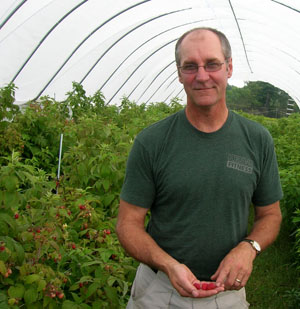
While consumers are enjoying fresh, locally-grown sweet tomatoes and crispy greens from Northern New York’s market gardeners, the growers are drawing on Northern New York Agricultural Development Program (NNYADP)-supported high tunnel research to extend production and sales into the fall season.
“Each high tunnel grower has his or her own crop plan and growing conditions. The Northern New York Agricultural Development Program season extension projects provide regional growers with first-hand and shared experiences to help them achieve maximum efficiency and profitability,” says project co-leader Amy Ivy, director of Cornell Cooperation Extension Clinton County, Plattsburgh, N.Y.
Regional growers have been applying NNYADP project results on how to graft tomatoes for high tunnel production, how to use seeding date to influence the production of three different greens, and the benefit of regular soil nutrient testing.
Tomatoes are a popular and profitable tunnel crop for fresh market vegetable growers.
“Grafting desirable tomato varieties onto vigorous, disease-resistant rootstock has shown significant results. All four varieties we graft-tested in 2010 outgrew and outproduced the non-grafted plants well into October,” says Cornell University Horticulture Professor H.C. Wien.
Trials with spinach, arugula and lettuce crops at the Cornell E.V. Baker Research Farm at Willsboro, N.Y., evaluated different seeding dates: August 21, September 5 and September 30 for spinach, arugula and lettuce. The crops were seeded in a high tunnel, a movable high tunnel, and outdoors with low cover.
“Planting date had a major influence on the productivity of the greens under all three season extension systems. A two-week difference in planting date reduced the number of harvests by half. The data illustrates the importance of a mid-late August planting to optimize fall-winter greens production under Northern New York growing conditions,” says Baker Farm Manager Michael Davis.
The trials also show that the quality of the greens could be maintained longer, without heat, by adding an additional low cover over the crop in the high tunnel. The crop could be harvested once it thawed during the day through December.
Fresh market grower and poultry producer Beth Spaugh-Barber of Rehoboth Homestead in Peru, N.Y., participated with the evaluation of foliar nutrient testing. The testing provides valuable information on the level of nutrients in plant leaves during the growth period.
Spaugh says, “Whenever the local and state Cornell Cooperative Extension staff visit the farm as part of a project, they notice things I have ignored and share really helpful ideas that improve our production and bottom line. The trips we made as part of this Northern New York project to farms that have been using high tunnels longer were nuts-and-bolts learning experiences.”
Adam Hainer of Juniper Hill Farm has created his own unique movable high tunnel that rolls on pipes at his farm in Wadhams, N.Y.. He says, “These regional research trials allow growers to see results before we invest in a system that may not have any potential for payback or profit. When the results are positive, we can invest confidently and have a regional resource to help us manage the new enterprise.”
Twelve growers attending one of the project’s farmer-to-farmer season extension learning workshops indicated an interest in adding high tunnels to their farms in St. Lawrence and Jefferson counties.
High tunnel production information for northern New York growers is online at http://www.nnyagdev.org/_horticulturecrops.htm#HIGH_TUNNEL_PRODUCTION.
The Northern New York Agricultural Development Program conducts research in Clinton, Essex, Franklin, Jefferson, Lewis and St. Lawrence counties. The New York State Legislature and Cornell University Agricultural Experiment Station are program funders.
See also: Cornell High Tunnels website.


